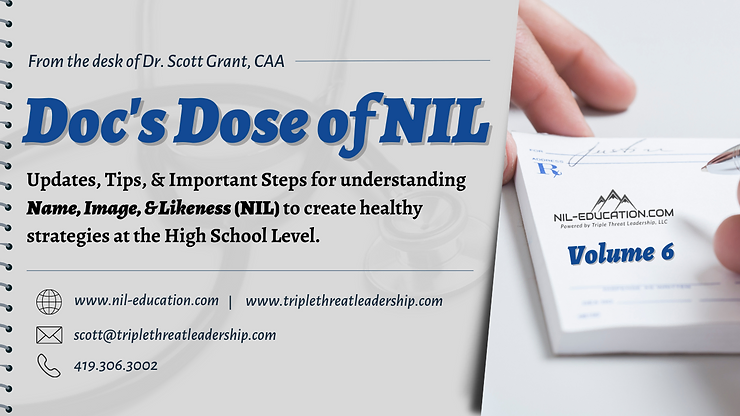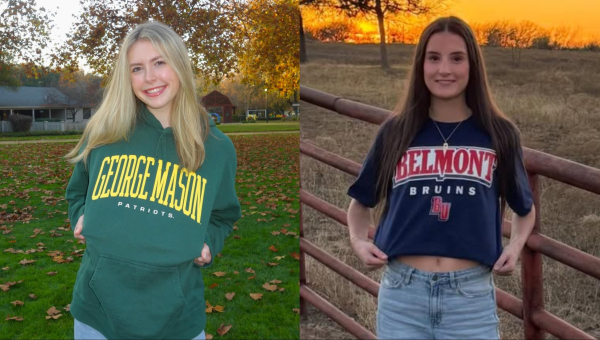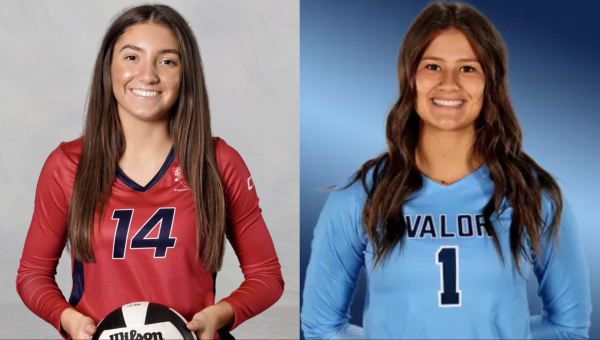
This content is provided FREE through our partnership with Dr. Scott Grant and Triple Threat Leadership/NIL Education to bring your family resources to learn the ins and outs about NIL, including the rules (each state is different), tactics, pitfalls, and marketplaces to take advantage of exciting opportunities available to student athletes.
As I sat here this morning drinking my coffee and thinking about these incredible conversations, there were a few comments that articulated some present themes within the majority that I wanted to share.
"Scott - we know NIL is coming, and it scares us because we don't really understand it, how it may impact our students, and where to even start. But we have so much going on with the day to day of running our schools / programs, it's just not a priority for us to focus on right now."
That's understandable, and I completely appreciate their honesty.
They literally just don't have much time for anything, let alone worrying about something that for many isn't a reality yet.
And even for those where NIL is already allowed, if it's not currently hitting them in the face with issues, it's tough to dedicate time and resources to figuring it out.
I also had a principal tell me it's "FARCH"... to which I responded, what is that? He then defined it for me.... as, you know...
"FARCH"
That the time where February and March turn into a big blur, and there are very few breaks and more things going on than you can imagine.
You've got calamity days, testing, an end of a long winter sports season, banquets, music performances, teacher PD sessions, sub coverage, preparation for prom & graduation, conversations about retirements and the search / hiring for new teachers.... and that's just a small part of the to-do list that additionally has the normal day to day activities as well.
Again - Absolutely understandable.
NIL is not a top priority at this point, (or even a low one for that matter).
And you can't blame anyone for that.
Additionally, after meeting with a group of principals & administrators in Ohio, which is the only state that has put it up for a vote and actually voted it down... A few administrators stated their frustration in this manner:
"Let's face it, for those of us in Ohio, the last time we voted this down one of the issues was that it would have gone into effect the day after the vote."
"There was / is no implementation plan ready for us from the State Athletic Association level. Or at least none that has ever been communicated with us."
These two responses piggybacked on the following feedback received from an Athletic Director in a southern state that is currently considering an NIL policy change who stated:
"Most likely when this passes, they'll (the state athletic association) sign an NIL company who they'll refer us to for education because they don't have the capacity to manage this internally, and when we call the state association to ask a question, they'll say to contact this company for more specific questions. Or they'll give us some online course we have to complete, and goodness knows we don't need another one of those."
THEY need a plan that THEY are going to support and manage to help us figure this out."
I do worry that if another state wide referendum is put up for a vote in Ohio, (which any school can push forward), there won't be a lot of lead time for PROACTIVE planning for schools, or organized SUPPORT from the OHSAA in truly understanding each piece of a new set of regulations.
The OHSAA's last set of safeguards left quite a bit of work on the plates of the schools / athletic administrators that they shouldn't be doing like looking at potential contracts and designating a "compliance officer".
You can read through what was voted down last year by clicking here: https://bit.ly/2022-OHSAA-NIL-Referendum
I can't speak for the OHSAA, as maybe they already have a plan to support one. I'd be more than willing to help them with that.
But with that being said, I do know first hand that many state associations are packaging the educational help needed by their Athletic Directors, and selling it as a sponsorship package for a substantial amount of money.
Sometimes I worry that the resources (both financially & educationally) those companies provide through that sponsorship doesn't exactly trickle down enough to the AD's.
If there are any State Athletic Association Directors reading this, please focus on what your AD's need first by ASKING them what they need.
Then find whoever provides that the best before you send the conversation over to your sponsorship arm where they will focus on who will pay the most for access to your AD's. But right now that's beside the point.
Districts have questions and need the state athletic associations to provide specific clarity of the regulations, potential application mishaps, and procedural considerations to ensure they're doing what they should be doing.
Because they don't have a lot of time to figure this out.
To take that a step further, here were a few of the questions that were asked during these recent discussions: "What are we going to be required to do if NIL passes in our state?
This is going to be different in EVERY STATE, because the policies are respective to their state athletic association. Again, there isn't a national governing body making these regulations like the NCAA. But, it needs to be clear what the School Administration is being required to do based upon the policy / bylaw approved.
"Why would the State Athletic Association require me to look at an NIL contract, or keep a copy? What am I supposed to do with that? I'm not a lawyer."
Some state policies are requiring student-athletes to turn in copies of their NIL deals to their school administration, or in the case of the failed OHSAA NIL referendum vote, they were being required to designate a compliance person who had to look through potential NIL deal's to ensure they didn't violate the OHSAA amateurism policy. No one other than a lawyer should be doing that in my opinion.
"Can our district set a limit on how much student-athletes can make?"
See a longer answer to this in the next question's response, but I doubt this does anything other than open you up to a lawsuit in some capacity.
"Can we create our own school policy that does not allow NIL for our student-athletes?"
Another great question. And after digging in further, absolutely you can.
Just because the OHSAA allows a certain number of coaching days, or a minimum grade point average, or the state allows open enrollment, that doesn't mean schools have to adopt those practices internally.
They could create a policy that is MORE restrictive.
But, I probably wouldn't suggest doing that for a lot of reasons, one being that you are taking control of and a somewhat negative stance on something that could potentially positively impact a kid / their family. That's part of the initial issue in the battle of NIL in the first place, and whether it's the right of anyone to control a person's right of publicity (name, image, & likeness).
Additionally, I'd assume any school that takes that pathway will have some kids consider or actually transfer to nearby schools not only for the potential opportunity to monetize their NIL, but also just because you're telling them they can't do something that the OHSAA is telling them they can.
"Why should I care, I'm a small rural school, we don't have any elite kids that are going to get paid millions."
To be honest, this is something I get asked a lot as AD's state - "this won't affect me, we are a small school", and I always use my high school as a prime example.
I grew up in a very small town that didn't have football and basketball was KING.
If there is a kid from my hometown that becomes a major recruit and NIL is allowed (it's currently not by the way), I'd assume that numerous businesses in town may "dip their toes" in the NIL game through some type of sponsorship/endorsement with that student-athlete from a community engagement standpoint to put our town / student-athlete / sport / community on the NIL map.
Chances are one of the local businesses may even be related to the student-athlete, and most likely, little kids in that town idolize that individual.
Not always, but it seems more often than not.
Additionally, and this was a major concern when NIL was first being integrated at the college level:
Because marketing budgets are always tight, money that would be directed to student-athlete NIL opportunities may be money that was directed away from what previously may have been given to support the Athletic Department as a whole.
Is this going to happen? Maybe, maybe not. There is no way to predict what will happen. But, as we discussed examples of current HS NIL Deals, it doesn't have to be your top athlete, but rather, it may be SA's already building large social followings, or hometown heroes, or those capitalizing on a unique attribute that aligns with a company's brand, or a plethora of other potential NIL deals / opportunities / activations. It's also important to understand that in the process of working to educate high school administrators and their stakeholders, I've never said NIL will be something that overturns their district, or where kids at every school will make millions of dollars, but rather, I've always focused on the fact that NIL will now become part of the educational process that you provide to your students and stakeholders in some manner. Whether that part becomes big or small, you may not fully know until it happens. But let's face it, many student-athletes (and their parents) are interested and curious about this “NIL thing” at the college & high school level that they’ve been seeing on television or reading about online. Most not only don't know where / how to appropriately and safely start, but rather, what they NEED TO KNOW in regards things such as:
- What NIL even is, and what it looks like at the High School level.
- If their state allows it, and what they exactly allow (or don't allow).
- Potential Red Flags & Grey Areas in the rules, as well as the contracts.
- Compliance considerations in regards to ensuring they do not impact their high school eligibility, as well as at the college level if they plan to play beyond graduation
- Tax implications and the potential impact on FAFSA & college grants / funding
- The key skills they need to learn / improve as they venture down the NIL pathway
As well as many other elements that are important to analyze as they move forward no matter what direction they choose.
Educational based athletics is a major part of the high school environment and experience, and that’s a good thing.
NIL is going to be part of that moving forward... whether that's already happened in your state, or whether you're one of the next ones to integrate it.
So as always, with any time that you do have, make sure that at minimum, you push your State Association Athletic Administrator Association or your district / regional elected athletic officials to ensure any CURRENT or PROPOSED NIL regulations are clarified for you, and you feel supported in that process of understanding.
If you don't, then push back on the State Athletic Association until you do.
And just a PS to parents - please note that many State Athletic Associations do not work directly with you, and won't answer your call. They will only work through the High School Athletic Director of your child's district.
Lastly, as I was walking out of my final event this week, I had a High School Principal turn to me and say -
"You need to speak more at Principal & Superintendent conferences, meetings, etc.. because even though my AD and are in the same building, we rarely have much time to truly sit down and talk about things like this. We at the administrative level outside of daily athletic oversight need more support in understanding NIL, especially since it seems like many of these state policies & regulations open our district up for potential lawsuits, workload changes, compliance reporting, and need for internal processes and structures to keep our district and stakeholders safe."
I couldn't have said it better myself, as I 100% agree.
Which is why I just finished proposals to speak at the Principal, School Board, and Superintendents conference.
This isn't just an athletics program issue.
But rather, it's a shift in educational programming that will need school district administrators to be on the same page internally.
Here to help in any way that I can as you find those little pockets of time to consider and plan!
(PS - If you're a principal, superintendent, or school board member and run a conference - feel free to let me know!)




